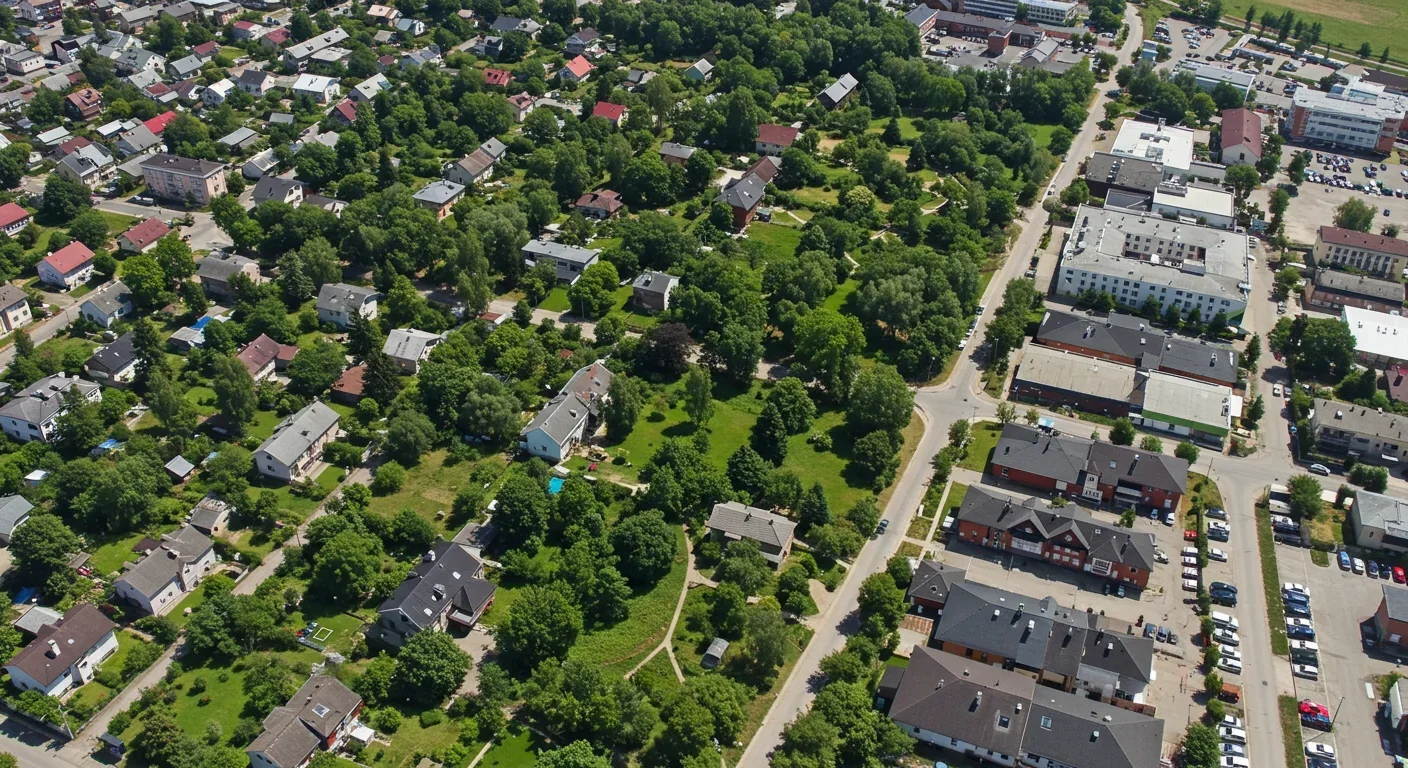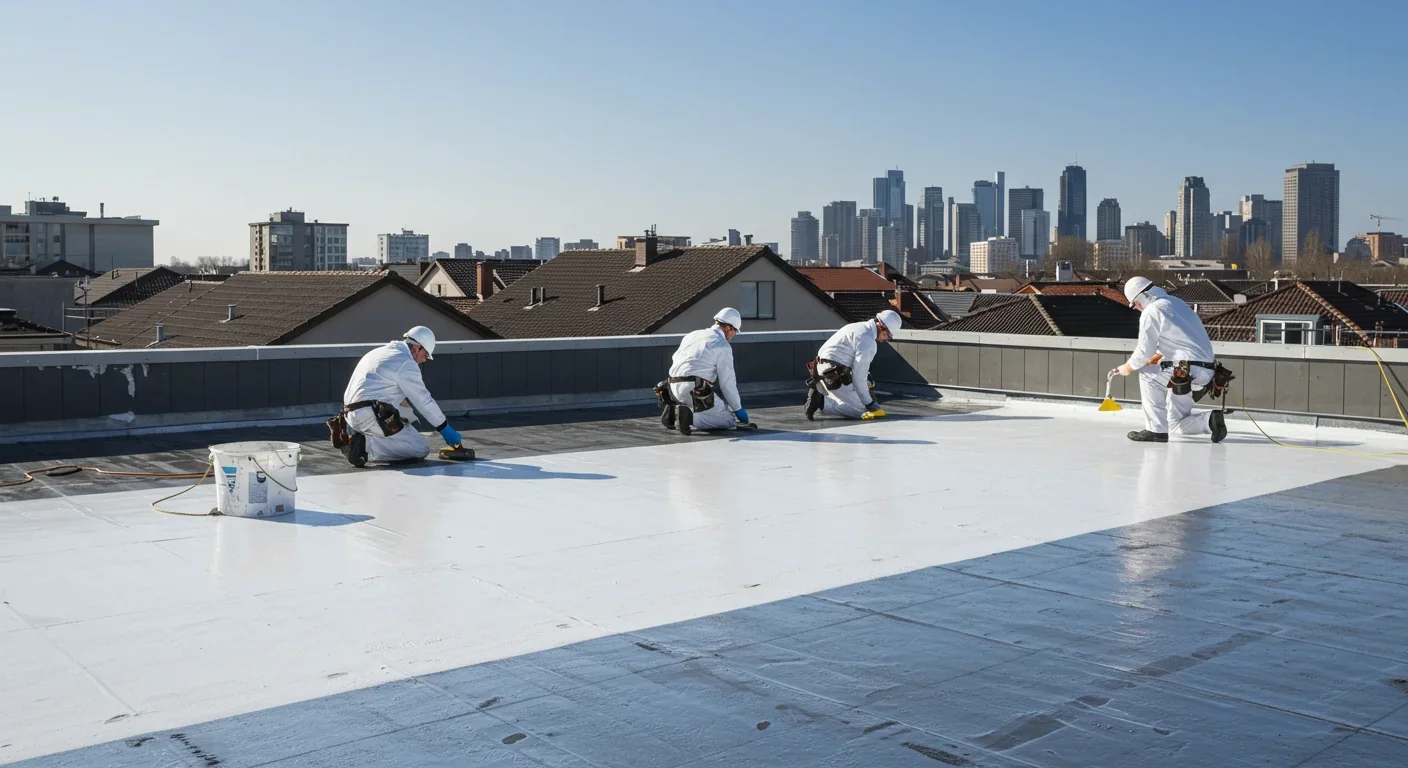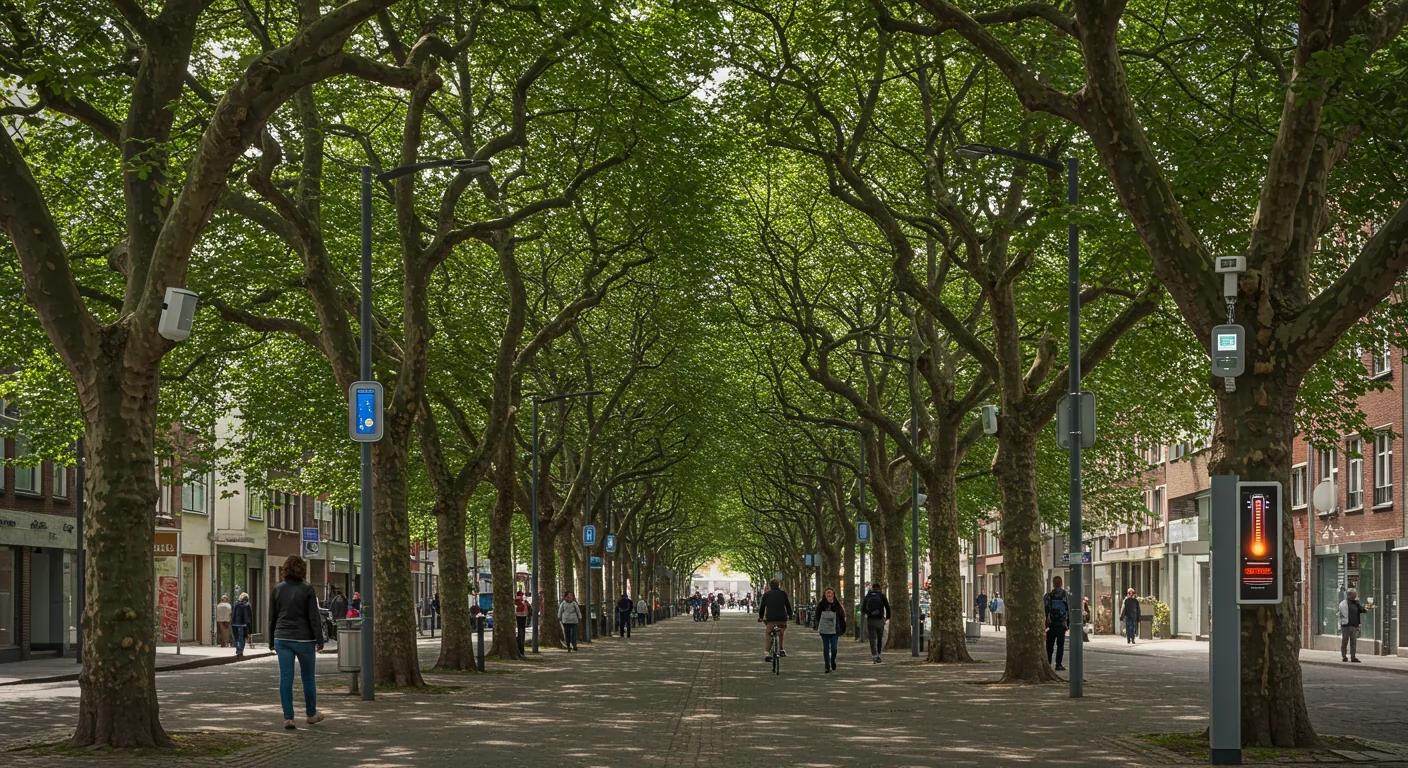Digital Pollution Tax: Can It Save Data Centers?

TL;DR: Urban heat islands make cities up to 14°F hotter than surrounding areas, causing thousands of heat deaths annually and driving up energy costs. Proven solutions like reflective roofs, green infrastructure, and urban trees can cool cities by several degrees with fast payback periods.

Step outside in downtown Charlotte on a summer afternoon and you'll feel it immediately—a wall of heat that seems to radiate from every surface. Walk a few miles to the city's outskirts and the air noticeably cools. This isn't your imagination. Parts of Charlotte measure up to 14 degrees hotter than neighboring areas, purely because of dark roofs and pavement. That temperature gap has a name: the urban heat island effect.
Urban heat islands transform cities into inadvertent ovens, trapping heat in concrete and asphalt that radiates back long after sunset. The phenomenon isn't just uncomfortable—it's deadly. During Europe's scorching 2024 summer, climate-driven temperature increases caused two out of every three heat deaths across 854 major cities. That's 16,500 people who died because their cities were hotter than they should have been.
Yet here's the paradox: we built these heat traps, which means we can dismantle them. Cities from Singapore to Philadelphia are proving that strategic interventions can restore thermal balance, sometimes cooling neighborhoods by several degrees. The question isn't whether we can fix urban heat islands—it's whether we'll act fast enough.
Urban heat islands form through a straightforward mechanism that most of us intuitively understand but rarely quantify. Cities replace natural landscapes—grasslands, forests, wetlands—with materials engineered for durability, not cooling. Concrete, asphalt, and dark roofing materials absorb and store solar radiation during the day, then release it slowly throughout the night. A typical city surface can be 1 to 7°C hotter than surrounding rural areas, according to comprehensive studies.
Think of it this way: a forest floor covered in leaves and soil acts like a sponge, absorbing rainwater that later evaporates and cools the air. Pavement, by contrast, is waterproof and heat-absorbent—more like a solar collector than a cooling system. That's why parking lots shimmer with heat on summer days while nearby parks feel refreshingly cool.
The heat-trapping effect intensifies with city density. Tall buildings create urban canyons that trap warm air, while reduced green space eliminates natural cooling through shade and evapotranspiration. Add millions of air conditioners, cars, and industrial facilities pumping out waste heat, and you've created a perfect recipe for sustained temperature elevation.
Recent research in European cities revealed that climate-driven warming made urban areas an average 2.2°C hotter than they would have been without greenhouse gas emissions. When you layer that on top of existing urban heat island effects, the cumulative temperature increase becomes genuinely dangerous.
The human toll of urban heat islands extends far beyond discomfort. Older adults bear the brunt, with 85% of Europe's 2024 heat deaths occurring among people over 65 and 41% among those over 85. These aren't abstract statistics—they represent grandparents who couldn't escape sweltering apartments, retirees with limited mobility, and vulnerable individuals in neighborhoods without adequate cooling infrastructure.
Heat stress triggers a cascade of physiological problems. The body's cooling systems—sweating and increased blood flow to the skin—demand extra work from the heart and kidneys. For people with cardiovascular disease, diabetes, or respiratory conditions, extreme heat can trigger hospital admissions. In Spain, extreme temperatures contributed to thousands of emergency cardiovascular admissions annually, though air pollution remains a larger contributor.
The health burden falls disproportionately on low-income neighborhoods. Research across 52 countries found that poorer households cluster in hotter locations, both between and within cities. These communities often lack tree canopy, have fewer parks, and contain older housing stock with inadequate insulation and no air conditioning. The urban heat island effect, in other words, disproportionately affects low-income neighbourhoods due to the absence of cooling infrastructure.
Beyond direct heat illness, elevated urban temperatures degrade air quality. Heat accelerates chemical reactions that produce ground-level ozone, with UHI-affected cities showing 10 to 20% higher ozone concentrations on warm summer days. That means more asthma attacks, more respiratory distress, and compounded health risks for already-vulnerable populations.
Urban heat islands create a vicious cycle that strains both household budgets and city infrastructure. When ambient temperatures climb, so does demand for air conditioning. Studies indicate that elevated urban temperatures force buildings to work harder to stay cool, sometimes increasing peak cooling demand by up to 27% in affected structures.
That surge in cooling demand translates directly to higher electricity bills, which hits low-income residents hardest. Many can't afford to run air conditioning continuously, forcing impossible choices between staying cool and paying for food or medicine. Those who do run AC contribute to increased power grid stress, raising the risk of brownouts during heat waves when demand peaks.
The infrastructure costs extend beyond electricity. Heat accelerates the deterioration of roads, causing asphalt to soften and crack. It stresses water systems as demand spikes for drinking water and irrigation. It even affects public transit, with extreme heat warping rail lines and forcing speed restrictions.
Economically, the case for mitigation is compelling. Cool roofs in Nanjing demonstrated a payback period of just 1.75 years, compared to 10.9 years for photovoltaic installations of the same area. The energy savings—6.5 kWh per square meter annually—represent an 8.6% reduction in total building energy consumption, with cooling energy use dropping by 15%.
The good news: we know how to cool cities. The challenge is implementing solutions at scale.
Reflective surfaces offer one of the fastest temperature reductions. High-albedo materials reflect rather than absorb solar radiation. New York City's Cool Roof Program applies reflective coatings to rooftops that can reduce surface temperatures by 16 to 22°C during peak summer days. Research consistently shows that cool roofs with a reflectance of 0.85 can achieve 15% cooling energy savings while modestly increasing heating demand by about 6.3%.
Charlotte is testing a similar approach, planning to coat city roads with titanium dioxide, a reflective compound that could reduce local heat exposure. Raleigh has already implemented the technology with measurable success. The Smart Surfaces Coalition estimates that strategic deployment of reflective materials could lower Charlotte's air temperature by 3.1 to 6.6°F.

Green roofs provide cooling through both shading and evapotranspiration. Vegetation-covered rooftops typically reduce surface temperatures by 2 to 5°C compared to traditional roofs, while also improving air quality and providing habitat for urban wildlife. Singapore's extensive green infrastructure demonstrates the potential, achieving surface cooling of up to 5°C compared to conventional urban settings.
Philadelphia's approach targets neighborhoods most at risk. The city is installing cool roof coatings on 150 homes in the Strawberry Mansion neighborhood, specifically in ZIP codes 19121 and 19132. The pilot will monitor ambient temperatures to determine whether clustered installations produce measurable neighborhood-level cooling—data that could justify citywide expansion.
Urban tree planting combines immediate cooling benefits with long-term ecosystem services. Trees lower ambient temperatures through shade and evapotranspiration, reducing the urban heat island effect while sequestering carbon and managing stormwater. The challenge lies in maintenance—young trees need consistent moisture to develop deep, stable root systems that provide sustained cooling benefits.
Street tree canopies shade roadways and sidewalks, reducing local air temperatures in ways that pedestrians immediately notice. The cooling effect isn't trivial—a well-shaded street can feel several degrees cooler than an exposed one on the same block.
Innovative building materials extend the toolkit further. Phase-change materials (PCMs) integrated into walls and roofs can achieve 29% annual energy savings and 14% thermal comfort improvements in Mediterranean climates. In hot, dry zones, optimized PCM configurations produce energy savings up to 42%. These materials absorb heat during the day and release it at night, smoothing temperature fluctuations inside buildings.
Emerging technologies are transforming UHI mitigation from reactive to proactive. IoT sensor networks, remote sensing, and AI-powered models enable real-time monitoring of urban heat patterns, allowing cities to identify hotspots and deploy targeted interventions.
Imagine a system that detects an approaching heat wave three days out, automatically increases irrigation to urban trees to maximize evaporative cooling, and alerts vulnerable residents to open cooling centers. That's not science fiction—the technology exists today. Cities like Singapore are already integrating sensor networks with green infrastructure to adaptively optimize cooling during extreme heat events.
Remote sensing satellites provide city-scale thermal mapping, revealing exactly which neighborhoods face the greatest heat exposure. This data-driven approach ensures that limited resources go where they'll have maximum impact, rather than being distributed based on political considerations or outdated assumptions.
Predictive modeling allows planners to simulate the thermal impacts of proposed developments before breaking ground. Will that new shopping center create a heat island? Would adding trees along this corridor reduce peak temperatures by enough to justify the cost? AI-powered models offer answers that inform smarter design choices from the outset.
UHI mitigation intersects directly with environmental justice. The neighborhoods experiencing the most severe heat—and the fewest resources to cope—are disproportionately home to low-income residents and communities of color. Addressing social vulnerability and urban justice issues is essential for equitable adaptation.
Philadelphia's cool roof pilot explicitly targets a high-risk neighborhood rather than wealthier areas that could more easily afford private cooling solutions. Charlotte has implemented incentive programs to encourage building retrofits in vulnerable communities. These approaches recognize that climate adaptation must actively counteract existing inequities rather than reinforce them.
The equity dimension extends to workplace exposure. Poorer individuals are more likely to work in occupations with greater exposure to the elements, meaning they face compounded heat risk both at home and at work. Construction workers, landscapers, delivery drivers, and agricultural laborers can't simply retreat to air-conditioned offices when temperatures spike.
Effective UHI mitigation therefore requires coordinated interventions across housing, labor policy, public health, and urban planning. It's not enough to plant trees downtown and call the problem solved. Cooling must reach the neighborhoods and populations facing the greatest risk.
While research on urban heat islands remains dominated by the Global North, rapidly urbanizing regions in Africa, South Asia, and Latin America face severe UHI effects with fewer resources to address them. Data scarcity in these regions hampers both research and intervention, creating knowledge gaps precisely where heat exposure is escalating most rapidly.
International cooperation could accelerate solutions. Cities facing similar climatic conditions could share data, test interventions collaboratively, and scale successful pilots more quickly than working in isolation. The Smart Surfaces Coalition's multi-city network offers one model for this type of knowledge exchange.
Technology transfer becomes critical—not just exporting solutions designed for wealthy cities, but co-developing approaches appropriate to local contexts, materials, and budgets. A green roof system that works brilliantly in Singapore may require significant adaptation for Dhaka or Lagos.

For policymakers and urban planners, the pathway forward is clear, if politically challenging. Cities should:
Mandate reflective roofing and light-colored pavements for new construction and major renovations
Dramatically expand urban tree canopy, with irrigation systems to ensure survival
Retrofit public buildings with cool roofs and green infrastructure
Create cooling centers in high-risk neighborhoods, accessible without cost during heat waves
Integrate heat mapping into all planning decisions, ensuring new development doesn't worsen existing heat islands
Prioritize vulnerable communities in adaptation spending
For residents, individual actions matter less than collective advocacy, but both have a role:
Push for municipal heat action plans that prioritize equity
Support urban forestry programs and tree planting initiatives
If you own property, consider reflective roofing when replacing shingles
Advocate for workplace heat protections, especially for outdoor workers
Check on elderly neighbors during heat waves
Charlotte's temperature differential—14 degrees between its hottest and coolest areas—isn't an outlier. It's typical of cities worldwide. What varies is the response.
Some cities treat urban heat as an unfortunate but unavoidable consequence of development. Others recognize it as a solvable design flaw. Singapore demonstrates that aggressive green infrastructure deployment can measurably cool urban environments. Philadelphia shows that neighborhood-scale interventions can be implemented cost-effectively. Nanjing proves that cool roofs pay for themselves in under two years.
The science is settled. The technologies exist. The economic case is compelling. What's missing is political will and coordinated implementation at the scale required.
Climate change is making every heat wave more intense, accounting for two-thirds of recent heat deaths in European cities. But the urban heat island effect is locally generated and locally solvable. We don't have to wait for international climate agreements or technological breakthroughs. We can start cooling our cities today.
The question is whether we'll act before the next heat wave claims thousands more lives—or whether we'll keep building saunas and wondering why people keep dying in them. Cities are heating up. The choice of what happens next belongs to us.

Recent breakthroughs in fusion technology—including 351,000-gauss magnetic fields, AI-driven plasma diagnostics, and net energy gain at the National Ignition Facility—are transforming fusion propulsion from science fiction to engineering frontier. Scientists now have a realistic pathway to accelerate spacecraft to 10% of light speed, enabling a 43-year journey to Alpha Centauri. While challenges remain in miniaturization, neutron management, and sustained operation, the physics barriers have ...

Epigenetic clocks measure DNA methylation patterns to calculate biological age, which predicts disease risk up to 30 years before symptoms appear. Landmark studies show that accelerated epigenetic aging forecasts cardiovascular disease, diabetes, and neurodegeneration with remarkable accuracy. Lifestyle interventions—Mediterranean diet, structured exercise, quality sleep, stress management—can measurably reverse biological aging, reducing epigenetic age by 1-2 years within months. Commercial ...

Data centers consumed 415 terawatt-hours of electricity in 2024 and will nearly double that by 2030, driven by AI's insatiable energy appetite. Despite tech giants' renewable pledges, actual emissions are up to 662% higher than reported due to accounting loopholes. A digital pollution tax—similar to Europe's carbon border tariff—could finally force the industry to invest in efficiency technologies like liquid cooling, waste heat recovery, and time-matched renewable power, transforming volunta...

Humans are hardwired to see invisible agents—gods, ghosts, conspiracies—thanks to the Hyperactive Agency Detection Device (HADD), an evolutionary survival mechanism that favored false alarms over fatal misses. This cognitive bias, rooted in brain regions like the temporoparietal junction and medial prefrontal cortex, generates religious beliefs, animistic worldviews, and conspiracy theories across all cultures. Understanding HADD doesn't eliminate belief, but it helps us recognize when our pa...

The bombardier beetle has perfected a chemical defense system that human engineers are still trying to replicate: a two-chamber micro-combustion engine that mixes hydroquinone and hydrogen peroxide to create explosive 100°C sprays at up to 500 pulses per second, aimed with 270-degree precision. This tiny insect's biochemical marvel is inspiring revolutionary technologies in aerospace propulsion, pharmaceutical delivery, and fire suppression. By 2030, beetle-inspired systems could position sat...

The U.S. faces a catastrophic care worker shortage driven by poverty-level wages, overwhelming burnout, and systemic undervaluation. With 99% of nursing homes hiring and 9.7 million openings projected by 2034, the crisis threatens patient safety, family stability, and economic productivity. Evidence-based solutions—wage reforms, streamlined training, technology integration, and policy enforcement—exist and work, but require sustained political will and cultural recognition that caregiving is ...

Every major AI model was trained on copyrighted text scraped without permission, triggering billion-dollar lawsuits and forcing a reckoning between innovation and creator rights. The future depends on finding balance between transformative AI development and fair compensation for the people whose work fuels it.